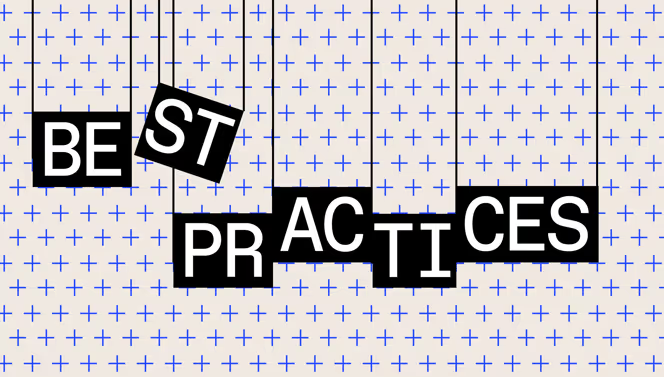Performance management goal setting: Examples and tips

Discover Workleap Officevibe's benchmark report on 12 key employee engagement metrics

Every organization has room for improvement. That’s why leaders set goals: to boost performance, add value for customers, and optimize employee efficiency.
Performance management goals are clear expectations and targets set for individual employees. They help workers understand what’s expected of them while allowing managers to measure progress. Kill two birds with one stone by aligning employee goals with big-picture business objectives, and your workforce and bottom line will thrive.
This guide teaches you how to set these goals, plus what to do when work goes off track.
Why is goal setting important in performance management?
Performance goals are objectives that employees must achieve within a specific timeframe. For example, increasing annual sales, boosting monthly website traffic, or improving staff retention numbers within a quarter are all performance goals. They usually link to larger organizational targets, from improving revenue to scaling the team, and when employees meet them, the company thrives.
Here are a few benefits of performance management objectives:
- Enhanced productivity: Goal setting helps motivate employees. When workers know what to work toward and why it's important, they move with purpose and focus.
- Better development: To achieve a goal, a team member may have to do additional training or take on new responsibilities. These objectives push employees to level up their skills and reach new heights.
- Improved communication: Performance goals allow leaders to clearly communicate role requirements to employees. A hit or a missed target is also an opportunity for a progression or mentorship conversation.
- Increased engagement: Performance targets help workers feel engaged with their work. Employees also better understand how achieving their individual goals helps the organization as a whole, deepening engagement.
- Greater accountability: Performance management objectives allow employees to see how they’re doing in real time and hold themselves accountable. Management can also clearly spot when intervention or support is required.
- Time and resource optimization: When employees have clear instructions, they’re more likely to use time and resources wisely. Goal setting provides detailed, coherent steps for employees to follow.
Workleap Performance helps maximize your organization’s employee goal-setting initiatives with flexible performance review cycles and feedback reporting tools. Using Workleap Performance, managers can clearly spot areas for improvement and proactively set goals around them.
Examples of performance management goals
There’s no one-size-fits-all performance goal. An HR colleague wouldn’t have the same targets as a finance employee. There’s a lot of variety, but below are a few of the most common performance management goal examples.
Finances
This performance goal category drives your company’s economic success and may include:
Increasing revenue
Set performance goals centered on increasing earnings over a specific time period. For example, you might ask employees to aim for a 3% quarterly revenue boost, matching company targets.
Decreasing costs
Lower costs increase operational efficiency and boost profits. Establish a performance goal to reduce quarterly spending by a certain achievable percentage.
Customers
These performance goals focus on a company’s end users. Frequently, these objectives include:
Improving brand perception
A better company perception can lead to more meaningful customer interactions. Set measurable goals around customer retention or lead generation. Monitor progress with key performance indicators (KPIs) like customer satisfaction scores.
Boosting customer experience
A better customer experience can boost sales and improve the company’s image. Focus objectives around understanding what your audience wants. Surveys and sales or marketing analytics provide excellent insights for establishing baselines. From there, set goals for how much you want to improve a particular metric.
Internal processes
Internal inefficiencies can really slow down business. Iron out any issues by focusing on:
Product excellence
Ask whether you’re regularly meeting quality assurance checks, and how your products measure up against the competition. Once you spot any areas for improvement, set manageable goals for your team to improve product quality.
Boosting efficiency
Ask how you can improve the speed and accuracy of internal processes like HR, manufacturing, or programming. It may even be possible to automate certain tasks, leading to quicker results and fewer errors.
Learning and growth
A higher-skilled workforce is productive and engaged. Level up your team’s learning potential by focusing on these goals:
Offering more professional development opportunities
Survey your employees about their current level of professional development, and find out where they’d like to see improvements. Then, provide HR with measurable goals around boosting satisfaction in this area. For example, you could aim for more frequent and interactive leadership training.
Improving company culture
Help employees feel better at work by taking a hard look at company culture. Find out whether work-life balance, inclusion, or any other aspect of the employee experience is lacking. Then, set your operations team the goal of improving these areas. Track their progress with occasional surveys.
How to write a performance goal: Key methodologies
There’s a science to goal-setting. Productive performance management objectives pinpoint areas of improvement and provide detailed plans for how to fix them. Here are a few methodologies to help you get it right.
The SMART Goal methodology
SMART stands for specific, measurable, achievable, relevant, and time-bound. In practice, it means defining a goal and why it matters while making sure it’s realistic. Then, set up a timeline and a way to measure progress. If the goal doesn’t seem reasonable, modify it.
SMART goals for performance review examples might include asking a salesperson to improve their numbers by a certain percentage. Or an operations manager might be tasked with decreasing spending by a particular amount.
The OKR methodology
OKR stands for objectives and key results. It describes a goal-setting methodology that aligns employee goals with organizational ones. Under the OKR method, a company establishes a high-level objective and then sets KPIs to assess success. Be aware that high-level initiatives must translate into trackable team goals.
You might want to improve customer engagement, so you ask your team to track and improve concurrent user numbers. There must be a way for your employees to reach their targets.
Locke and Latham’s 5 principles
Locke and Latham’s five principles are clarity, challenge, commitment, feedback, and complexity. These descriptors define the worthiness of any given objective.
When setting performance goals, check whether they’re clear and present a challenge. Ask whether teams feel committed to them, and establish how you plan to gather feedback on progress. Ensure that goals aren’t overly complex and have clear action plans supporting them.
BHAG Goals
BHAGs, or “Big Hairy Audacious Goals,” are reach-for-the-stars objectives that can take decades to complete.
BHAGs provide general direction for your organization, but they’re not short-term objectives. This can make them tricky to break down into bite-sized actions and tough to measure.
The Goal Pyramid methodology
The Goal Pyramid methodology helps organizations order objectives by timeframe, from short-term to long-term. Achievable short-term targets make up the top of the pyramid, while long-term ones sit at the base. It’s a highly effective approach for breaking bigger initiatives into immediate action items.
Performance management best practices
Head into your performance management goal-setting session with these best practices in mind:
- Gather accurate performance metrics: Collect quantitative and qualitative data on progress so you can monitor timelines and milestones. Use Workleap Performance to get continual feedback and AI-driven performance insights.
- Set up continuous review and feedback loops: Consistently check in on goal progress. This lets you provide employees with actionable feedback both inside and outside of performance reviews.
- Provide proper training: Employees can only meet goals with the right skillset. Hold regular training sessions to ensure your workforce is equipped to complete their tasks.
- Give regular recognition: Timely acknowledgement of a job well done helps employees feel seen. Recognizing your team’s accomplishments lets them know that management has their backs.
How to improve the quality of work: 5 tips
Worried about work going off course? Use the following tips to keep progress moving in the right direction:
- Communicate: Both positive and negative feedback are powerful tools. Clearly transmit constructive criticism to employees, but avoid demotivating them by focusing too heavily on poor performance. Instead, adopt a solutions-oriented mindset.
- Prioritize: Long-term flashy goals are attractive but can sometimes seem unachievable. Prioritize short-term goals with an eye for customer satisfaction and the best use of current resources.
- Delegate: Encourage management to trust their team to work autonomously. If leaders use appropriate progress-tracking tools, they’ll know when work lags without hovering over people’s shoulders.
- Automate: Recent advances mean tech can do much of the heavy lifting for you. Let AI-driven tools take over busy work so employees can focus on more complex tasks.
- Make meetings count: Make sure meetings are necessary so you’re not wasting time and employee productivity. Quick daily or weekly stand-ups can be a great tool, helping leaders check in on progress and resolve issues.
Drive better performance management initiatives with Workleap
Performance management objectives help you track how well your team is doing and give them a way to improve. They also give your organization a clear roadmap for achieving its vision.
Leverage Workleap Performance to gather razor-sharp insights and AI-driven advice. You’ll hold better performance reviews and never miss an opportunity to improve.
Demo Workleap today and see how these tools can transform your organization’s goal-setting processes.
Give HR and managers the clarity, confidence, and connection to lead better every day.


%20(1).avif)


.avif)
.avif)



%202.avif)




